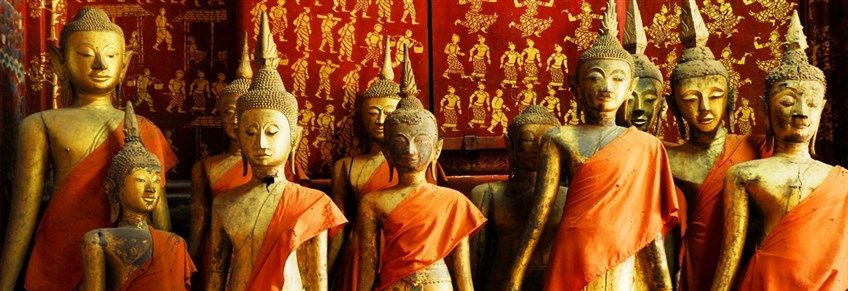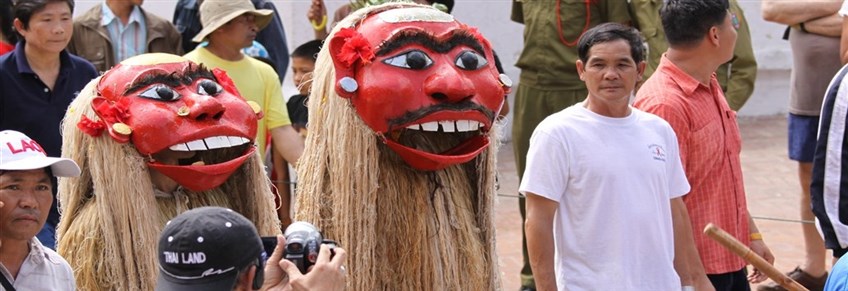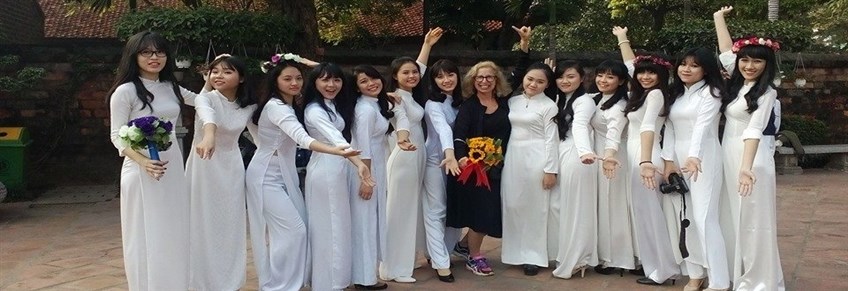
Laos is a land locked country that is often overlooked because of the popularity of its neighbors, especially Vietnam and Thailand but its popularity is rising, and rightly so. It’s a fairly poor country, mountainous and beautiful. Today’s boundaries were set by the French early in the 20th Century but even after independence in 1953 there was constant struggle through the era of the Vietnam War and then the Pathet Lao Communists until gradually it opened its borders to investment and tourism only towards the end of the last century. To that extent there has been far less foreign contact in Laos than in the other countries of Indo China.
It is taking some time for the infrastructure to catch up with many roads still unpaved by the main ones are now all asphalt and the only problems will be in remote areas when there has been heavy rain.
The population is fairly small but it does include almost 50 different ethnic groups so there is certainly diversity. Three of them form around 75% of the population and the whole population falls into just 4 linguistic groups. No visitor to Laos will have more than a few words of the local language but those who try will find the locals appreciative.
When Is the Best Time to Visit?
There are really just two seasons in Laos, dry and rainy with many people actually happy to be there between May and October, the rainy season. It will be a matter of accepting some fairly heavy rain, most afternoons but not necessarily foe any prolonged periods.
The advantage of traveling for a Laos holiday then is there are fewer crowds and prices fall. In some years however the Mekong River can flood, notably during July or August.
The dry season starts in November and lasts until April and is noted for its relatively moderate temperatures and dry days. It may actually drop down to 10C overnight. However towards the end of this period day time temperatures can reach 40C and sometimes the last couple of months in the dry season are described instead as a third season; hot.

Customs Regulations
Anyone caught carrying prohibited drugs can expect the severest of sentences, monetary and detention. Weapons of any sort are also forbidden. Ignorance and a foreign passport is no defense whatsoever.
Tourists cannot take images of a Buddha out of the country, nor artefacts and antiques. In some circumstances with the correct documentation you can export some cultural items but no one should try to do this without seeking proper advice and then written permission.
The usual tobacco and alcohol allowances apply.
Language
Lao is the national language though you can expect to find English spoken in the main tourist areas. Chinese, Vietnamese as well as Thai are likely to be understood in those areas as well. To a lesser extent other European languages exist amongst those educated, mostly in France, in the 1970s and 80s.
It is worth learning some numbers and the usual greeting and response for when you meet any locals.
Currency
The currency of Laos is the Kip and it comes in note denominations between 500 and 100,000. The approximate exchange rate is 8,000 to US$1.
Credit cards are widely accepted in cities, and in hotels, shops and restaurants in tourist areas though not in most remote places and transaction fees will always be higher than the norm.
The largest notes are uncommon and if you use an ATM to withdraw cash you are likely to get 50 20,000 notes rather than 5 20,000 notes or even 1 100,000 note. It does mean you are likely to be carrying a wallet full of notes most of the time.
There will be a daily cash limit of perhaps 2,000,000 but you will be charged a high rate for the transaction, typically 40,000, representing $5 for obtaining $250.
There will be no ATMs in remote areas and tourists should ensure they have sufficient local cash because exchanging in these areas will also be difficult at times and you do not want to be left short.
Bargaining
Where a price tag is attached to an item you should not try to bargain. Grocery stores and restaurants will have fixed prices though bargaining is common in the markets though there may not be the flexibility encountered in neighboring countries.
What you should not do is lose your temper; you are on holiday and should be having fun. Deep down you should think of how much you are haggling over and if you want the item, then buy it. If you try the tactic of walking away you may get a response and a better offer but do not count on it if the seller feels he or she will be losing face.
There are many interesting things to buy; silks and other textiles, local crafts and jewelry. While some are available in Thailand some of these great memories of Indo China actually originate with the hill tribes of Laos. Anyone on a Laos holiday as well as visiting other neighboring countries will certainly help the local economy by buying from source.
Weaving is a great skill which has actually attracted many people from abroad to come to study the art which revived after the fall of the communist regime.

Working
Bank opening hours are Monday to Friday 0830 – 1530 while government offices are likely to be open until 1600 but there will be a lunch hour, 1200 – 1300. Bureaucracy moves slowly in Laos so be prepared.
Shops will vary depending on location but those on Laos travels can expect 0900 to 1800 minimum though they are likely to all have a lunch hour and most will close on Sundays. Previously lunch hours were sometimes actually two hours, something the Lao traders learnt from their colonial masters, the French.
Public Holidays
Some of the Public Holidays vary year by year depending on the lunar calendar*. The dates below are for 2017 and give a good guide to the time of year they will always occur. Government offices will always be closed on these days and while some shops will be open that cannot be guaranteed.
There are also festivals, some of which coincide with these days but others celebrate the harvest, the call for rain at the end of the dry season and later in the year the celebration of water.
1st January – New Year’s Day
5th January – Pathet Lao Day
20th January – Army Day
*28th February – Chinese New Year
8th March – International Women’s Day
22nd March – Day of the People’s Party
*13th April – Pi Mai (Lao New Year)
1st May – International Labor Day
*3rd May – Buddha’s Birthday
1st June – Children’s Day
13th July - Khao Pansa when the Buddhist Fast starts
13th August - Lao Issara (celebrating Free Laos)
5th October – Bouk ok Pansa when the Buddhist Fast finishes
12th October – Day of Liberation
2nd December – National Day of Laos
Visas
A small number of nationalities do not require visa for entry but in terms of Westerners it is only the Swiss that are exempt. Everyone else needs a visa either issued by a consulate in their home country or now available on arrival at airports or some border crossings. The price varies by nationality between $30 and $42 currently.
After reading this Laos Travel Guide you should check to see that nothing has changed.
Processing time varies with consulate, and the price paid. 30 day visa are common and extensions can be obtained in various ways though it will involve surrendering your passport if you do that via an agency that will courier it to the capital Vientiane. Often the best way is to go back across the border for a day.

Dos and Don’ts
Laos has only basic healthcare so visitors may be advised to bring basic medicines and prescription drugs that they might need. You can expect to find a fairly relaxed atmosphere as long as you follow some basic rules and show respect for the local culture and religion.
Do
• Understand the normal form of greeting
Dress modestly in any religious environment. If in doubt dress modestly anyway in case you change your plans during the day
• Bow your head slightly in the presence of a Buddha and monks
• Take off your shoes on entering a house
• Accept drink or food if it is offered even if you are neither thirsty nor hungry
• Be patient because things can take time
Don’t
• Touch the head of any Lao person
• Dress immodestly anywhere
• Drink tap water; there is plenty of bottled water available for drinking
• Get drunk; it is disrespectful
• Disrespect a Buddha by touching it or turning your back on it
• Leave litter anywhere
Place your feet in such a way that they appear to be pointing or to be in any prominent position. In common with the rest of South East Asia the feet are regarded as the dirtiest part of the body.
Safety
A Laos family holiday is perfect because the locals love children and it is likely families will be able to communicate with locals very well. Certainly there are no fears from a safety point of view.
Everyone needs to have some form of ID though a photocopy of a passport should be sufficient. You should keep valuable documents in a safe place and photocopies of them all. It is unwise to allow anyone to scan or photocopy your passport because scans and photocopies will have a value and are sometimes used for money laundering.
Petty theft, pickpocketing and bag snatching is possible in the cities so beware. There is a high level of corruption as a fact of life but that should not affect anyone on a Laos holiday.
Drugs are a problem and should be avoided at all costs.
Those on Laos tours should take precautions against malaria as well as carrying insect repellant. Medical facilities are limited and tourists are advised to carry a simple medical kit. Good medical insurance is essential and those visiting the country using a good travel company will have the advantage of its expertise.

Scams
Sometimes foreigners are intentionally tempted to buy drugs; tuk-tuk drivers in collaboration with the police are looking for money effectively; remember that the police are often in plain clothes. It is wrong to show any remote interest in drugs, even as a joke.
If you hire a motorcycle from a doubtful company it is possible that someone with a spare key will follow, take the bike and charge the renter for a replacement. They may alternatively scratch it or disable it and charge a huge repair fee.
There will always be people who have an incentive to lead visitors to a particular hotel or restaurant. It is a matter of being sensible in border areas or transportation centers. Likewise when looking for taxis it is important to only take a proper taxi in case a local driver sees an opportunity. Those on organized tours should always be safe from such problems.
Summary
The development of tourism in Laos is fairly recent compared with its near neighbors. It is a poor country yet costs may actually be higher than in the more prosperous countries nearby. The important thing as has already been mentioned in this Laos Travel Guide is to keep smiling and enjoy the wonderful environment. There is a great deal to see and do in Laos and it is a relatively new path that tourists are treading.
The locals are naturally welcoming but they will expect everyone on a Laos holiday to respect their religion and culture.
Some problems do occur but they are no more common or serious than those that occur in all parts of the world when people gather in numbers; towns and cities and popular attractions. It is just a matter of employing common sense. This Laos Travel Guide is a good starting point for anyone thinking about a Laos holiday or combining Laos with other countries in the region.











